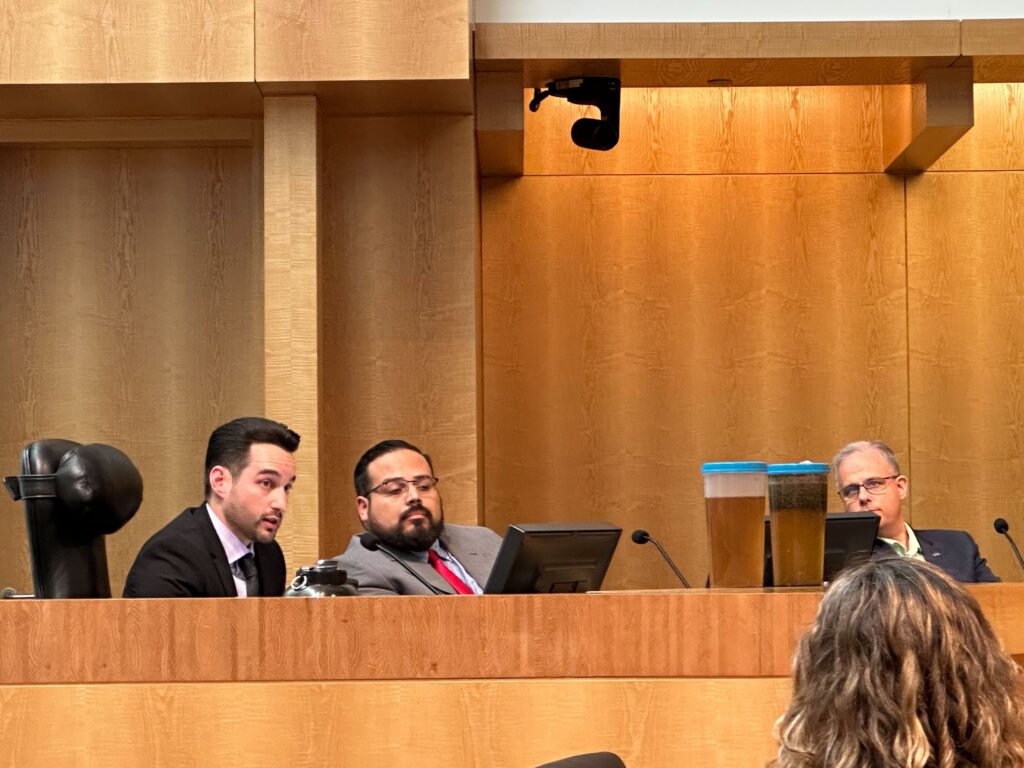Things got heated at Tuesday’s San Jose City Council meeting when councilmembers reversed a prior decision to use more than $3 million of Measure T funds for the restoration of Lake Cunningham in East San Jose.
This week, councilmembers voted 8-3 to divert the remaining $3.2 million in funds from the environmental protection budget into the public safety reserve, with Councilmembers Domingo Candelas, Peter Ortiz and Omar Torres dissenting. The money was previously allocated in 2021 to help improve Lake Cunningham’s water quality. Instead, the funds will be transferred for infrastructure projects like a new fire station. The councilmembers opposing the decision argued the $3.2 million should be used toward the lake’s restoration.
“There’s an environmental disaster on Lake Cunningham with regards to the water quality,” Candelas, who represents the area, told San José Spotlight. “We need to fulfill our commitment to environmental water quality projects as we promised to voters. Simply shifting the environmental funds to leave in the bank is not an action in good faith of the voters or taxpayers.”


Voters passed Measure T, a $650 million disaster preparedness bond, in the 2018 for road improvements, emergency services and flood control. The environmental protection portion of the bond included nearly $50 million for flood prevention and water quality contamination, according to city documents. The city used $46 million of those funds in a $93 million land deal to purchase and preserve 972 acres of Coyote Valley, which left about $3.2 million. Councilmembers Candelas, Ortiz and Torres wanted to use these dollars to address the long-ignored issues at Lake Cunningham.
Residents once enjoyed the man-made lake off Tully Road for fishing and boating. Several years ago the lake was declared an unsafe, feces-and fungi-filled swamp after decades of neglect. Over the years, former Councilmember Sylvia Arenas, who represented the area, advocated for Measure T funding to clean the lake. Candelas wants to follow in his predecessor’s footsteps. More than 300 residents sent letters or spoke at the meeting in support of the lake’s restoration.
“I’m worried that it will be even more years before we could see investments in Lake Cunningham,” Candelas said. “This is one of the most disadvantaged communities in San Jose, and if our equity conversation is more than talk, this is the opportunity to show it.”
Cleaning up the lake would be a massive undertaking. A recent study by city staff found it would take anywhere from $3 million to $20 million to restore the lake, depending on the level of infrastructure restoration.
However, the council majority said it would be a misuse of Measure T dollars.
“When we talk about the environmental component of the measure, it was strictly and solely related to Coyote Valley,” Councilmember Sergio Jimenez said. “Lake Cunningham wasn’t part of that.”
Councilmember Arjun Batra, who formerly served on the Measure T advisory committee that oversaw how dollars were spent, said the money was meant for disaster preparedness and public safety. To spend it on anything else would be “disrespectful” to voters.
“The question we should be spending our time on is how are we going to fund the rest of the money needed to get these safety projects done?” Batra said.
The city is planning to build out four different fire stations and three new facilities for the San Jose Police Department. Councilmember David Cohen said because it’s harder to get grant funding for public safety infrastructure projects than environmental projects, he would rather see the dollars put in the public safety reserve which acts as a bank for such projects.
“Economic challenges have changed since (the measure passed) and so therefore I’m more concerned about using any resources we have,” Cohen said. “I think it’s prudent for us at this time to put everything into the reserve for Measure T in general.”
Cohen also said $3.2 million is not enough to restore Lake Cunningham for recreational use. He would rather wait until the city has a better analysis on a funding and restoration timeline. Candelas argued it’s better for the city to invest in cleaning now because it will make it easier to get state and federal grants, as well as buy in from private investors.
“We have had conversations with our partners at the federal and regional level. They’re aware of the historical neglect, and they are ready to support improvements,” Candelas said. “But that requires a city to have skin in the game.”
Contact Jana Kadah at [email protected] or follow @Jana_Kadah on Twitter.



Leave a Reply
You must be logged in to post a comment.